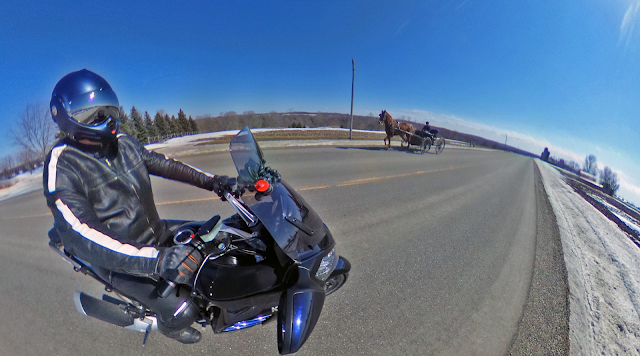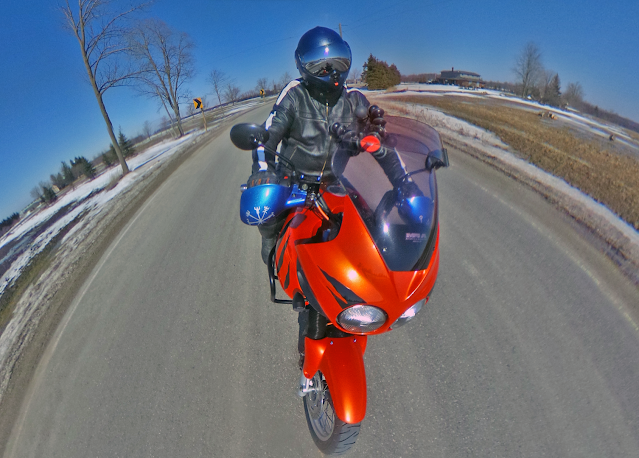 On Friday, July 13th, while thousands of people lined up to get into Port Dover, I left the cottage early (just before 7am) and headed out on my planned circumnavigation of the Kawartha Highlands Park. It was already well into the twenties Celsius and humid when I left. The fire roads into the cottage are a roller coaster rally stage of gravel over muskeg and Canadian Shield with tough, weedy firs and birch trees growing in the cracks. It's fun in a car but a bit nerve wracking on a bike.
On Friday, July 13th, while thousands of people lined up to get into Port Dover, I left the cottage early (just before 7am) and headed out on my planned circumnavigation of the Kawartha Highlands Park. It was already well into the twenties Celsius and humid when I left. The fire roads into the cottage are a roller coaster rally stage of gravel over muskeg and Canadian Shield with tough, weedy firs and birch trees growing in the cracks. It's fun in a car but a bit nerve wracking on a bike.It's tourist season in the Haliburton Highlands and on the weekends the roads actually have some traffic (like, a few vehicles: Canadian country traffic), but on this Friday morning it was quiet. I was lucky to see another vehicle pass me in any five minute span when I set out and the cottage road was just me and the bears.
I pulled in just as the breakfast buffet was underway. It was twenty bucks for breakfast all in, but it was all you can drink quality coffee and real juices along with a buffet all you can eat hot breakfast with fruit and all the other odds and ends you'd expect from a high end resort. If you've got the time and you're up that way, Viamede is a nice way to start a day of riding, and you're looked after by a fantastic staff while eating a great breakfast in a beautiful environment. It's probably cheaper than a lousy hot dog at Port Dover and no line up.
 With the slower, technical roads around Stoney Lake behind me, I struck north, deeper into the Shield. 46 and the 504 were both full of fast sweepers that seldom had me on the crown of my tires. I pulled into Coe Hill Cafe about 10:30am. After three hours on the bike my knees needed a rest, so it was coffee time. It was me and four tables of retirees all talking politics and telling 'in my day' stories (they'd all owned bikes at some point).
With the slower, technical roads around Stoney Lake behind me, I struck north, deeper into the Shield. 46 and the 504 were both full of fast sweepers that seldom had me on the crown of my tires. I pulled into Coe Hill Cafe about 10:30am. After three hours on the bike my knees needed a rest, so it was coffee time. It was me and four tables of retirees all talking politics and telling 'in my day' stories (they'd all owned bikes at some point). From Tory Hill I was dropping south along the western side of The Kawartha Highlands Provincial Park, once again on near empty roads. The Tiger had burned off most of a tank of gas and was light and eager, and after six hot hours in the saddle, I was looking forward to a swim in the lake. Like that post breakfast section around the end of Upper Stoney Lake, this road felt weightless and easy. I get to the end of sections of road like that and realize I'd forgotten where I end and the bike begins.
From Tory Hill I was dropping south along the western side of The Kawartha Highlands Provincial Park, once again on near empty roads. The Tiger had burned off most of a tank of gas and was light and eager, and after six hot hours in the saddle, I was looking forward to a swim in the lake. Like that post breakfast section around the end of Upper Stoney Lake, this road felt weightless and easy. I get to the end of sections of road like that and realize I'd forgotten where I end and the bike begins. I was back at the cottage by 2pm and in the lake shortly thereafter. Once again the Haliburton Highlands had impressed, offering an assortment of interesting roads that are vanishingly rare in the table-top flat South West where I live. The Tiger was once again a rock star, prompting discussions wherever we went and starting at the touch of a button. It carried me and two panniers full of tools and rain gear around the Kawartha Highlands while soaking up bumps on some truly awful pavement and feeling like an eager sports bike when the going got smooth and twisty. Best of all, we managed it on near empty roads with no delays and some spectacular scenery.
I was back at the cottage by 2pm and in the lake shortly thereafter. Once again the Haliburton Highlands had impressed, offering an assortment of interesting roads that are vanishingly rare in the table-top flat South West where I live. The Tiger was once again a rock star, prompting discussions wherever we went and starting at the touch of a button. It carried me and two panniers full of tools and rain gear around the Kawartha Highlands while soaking up bumps on some truly awful pavement and feeling like an eager sports bike when the going got smooth and twisty. Best of all, we managed it on near empty roads with no delays and some spectacular scenery.Best Friday the thirteenth ride yet! About three hundred kilometres on near empty roads through picture postcard scenery and not a crowd or line up in sight. That's my idea of what a motorcycling celebration should look like. I'll leave the dressing up like a pirate and lining up to look at other pirates to the people think that is motorcycling. I prefer to actually go for a technically challenging and picturesque ride, and boy do the Haliburton Highlands deliver.
 |
| Early morning map check after my first breakfast destination proved unserviceable... |
Here are some full 360° images from the ride:
The cottage fire road out of Bass Lake. - Spherical Image - RICOH THETA
The twists and turns of the Haliburton Highlands. - Spherical Image - RICOH THETA
Lakes, woods and Canadian Shield. - Spherical Image - RICOH THETA
The on-bike 360 footage was captured by a Ricoh Theta set to auto shoot every 30 seconds, so you can set and forget it. The images are screen grabs from out of the 360 panoramas. You can lean how to do this yourself (it's easy!) here.































































